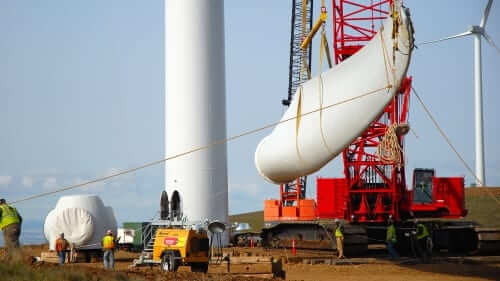News roundup: Choose a clean energy future, zero-energy companies, big players in global wind
In today’s midweek roundup, the NRDC’s Franz Matzner urges Congress to choose a clean energy future by extending the PTC and ITC, IKEA sets the example as a future zero-energy company, and the U.S. and China excel in wind capacity.
Franz Matzner is the associate director of government affairs for the NRDC. In a post for Renewable Energy World, he urges Congress to do the right thing and choose a clean energy future:
- Senate Finance Committee Chairman Wyden has officially begun consideration of legislation to reinstate a suite of tax credits that big polluters and their allies succeeded in getting Congress to let expire, including vital, commonsense policies that promote clean energy.
- The Renewable Electricity Production Tax Credit (PTC) offers a per-kilowatt-hour tax credit for electricity generated by qualified energy resources, including wind and geothermal. It has played a valuable role in advancing wind power and nurturing an industry that now provides jobs to more than 80,000 Americans. In 2012 alone, the tax credit helped the wind industry catalyze $25 billion in private investment in our economy. Over 70 percent of U.S. congressional districts have either a wind project or wind-related manufacturing facility, bringing local economic development to the region.
- The Business Energy Investment Tax Credit (ITC) is a crucial strategy to launch the U.S. offshore wind industry, although it also applies to other resources like solar and geothermal. Considering that the Atlantic coast in particular has strong winds with an estimated potential of more than 1,300 gigawatts of energy generation, harnessing just 52 gigawatts offshore could power about 14 million U.S. homes and create more than $200 billion in new economic activity along the coast. Solar projects and other technologies supported through the ITC should also be eligible if they begin construction prior to the end of the credit period.
- In short, we need every wind turbine, solar panel, electric vehicle, and energy-efficient heater if we’re going to cut the carbon pollution driving climate change and to move America closer to a more stable and prosperous future. Both chambers of Congress should follow Chairman Wyden's lead and waste no time reinstating the full suite of clean energy credits.
IKEA has pledged to become a net zero-energy company by 2020 with the help of wind power, and, according to Washington Post blogger Dominic Basulto, that’s just what we need to combat climate change:
- So here’s an innovative idea: All companies should pledge to become zero-energy companies by 2050. What that means in layman’s terms is that companies should reduce their net energy consumption to zero, producing more energy than they consume. To achieve that aggressive goal, they will be asked to go way beyond just reducing their carbon footprint – they will need to start thinking not just of how they consume energy, but also how they produce it.
- The template for such a model would be IKEA, which has pledged to become a zero-energy company by the year 2020. The company has already earmarked $2 billion for renewable energy projects, including its latest project – a new wind farm 110 miles south of Chicago. Already, the numbers from the company’s most recent sustainability report hints that it can be achieved. In 2013, renewable energy sources accounted for 37 percent of the company’s total energy needs. The company now owns wind projects in eight countries and has installed more than 550,000 solar panels. That massive new wind farm in Illinois, once it’s operational in 2015, will be able to supply 165 percent of the company’s electricity needs for its U.S. operations and up to 18 percent of the company’s global electricity needs.
The United States and China are global wind leaders and will stay that way with the right policies in place, according to a new GWEC report:
- Globally, wind power installations will increase by 34 percent — to 47.3 GW in 2014 and hit 64 GW in 2018 — driven up by growth in China and recovery in the United States, according to the Global Wind Energy Council (GWEC). Brussels-based GWEC sees a rebound this year after a 22 percent decline, to 35.5 GW, in 2013. The global cumulative installations for 2014 are estimated to reach 365.5 GW, while in 2018 installations could be as high as 596.4 GW.
- "The global market is back on track for 2014," said Steve Sawyer, GWEC secretary general. "A strong Chinese market, recovery in the U.S. and an increasing role for emerging economies in the global market means that after 2014, the market will resume its steady if unspectacular growth, and end up just about doubling total global installations during the five year period to 2018."
- "Wind is now a mainstream technology, and a central part of electricity market development in an increasing number of countries," said Sawyer. "But for the industry to reach its full potential, it is essential that governments get serious about climate change, and soon."
Celebrate wind power and Earth Day during #IHeartRenewables week!
Be sure to check out this week’s other roundups:
- Tuesday: PTC builds momentum, Ohio's RPS means consumer savings, driving down prices in Texas
- Monday: The PTC's importance, stepping up NC clean energy, a strong year for global wind
Sources:
Franz Matzner, “Tax Code of Honor: US Congress Must Choose a Clean Energy Future.” Renewable Energy World. 10 April 2014.
Dominic Basulto, “By 2050, every company needs to be a zero-energy company. Or else.” Washington Post Blogs. 15 April 2014.
Barbara Vergetis Lundin, “China, U.S. driving wind capacity.” Fierce Energy. 15 April 2014.




